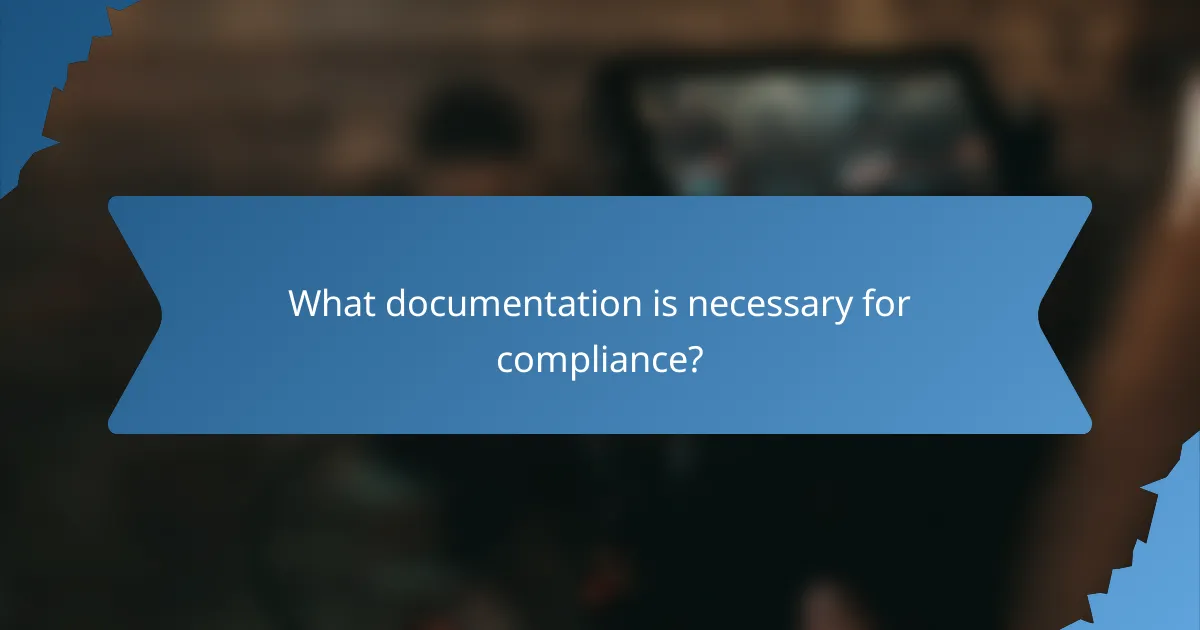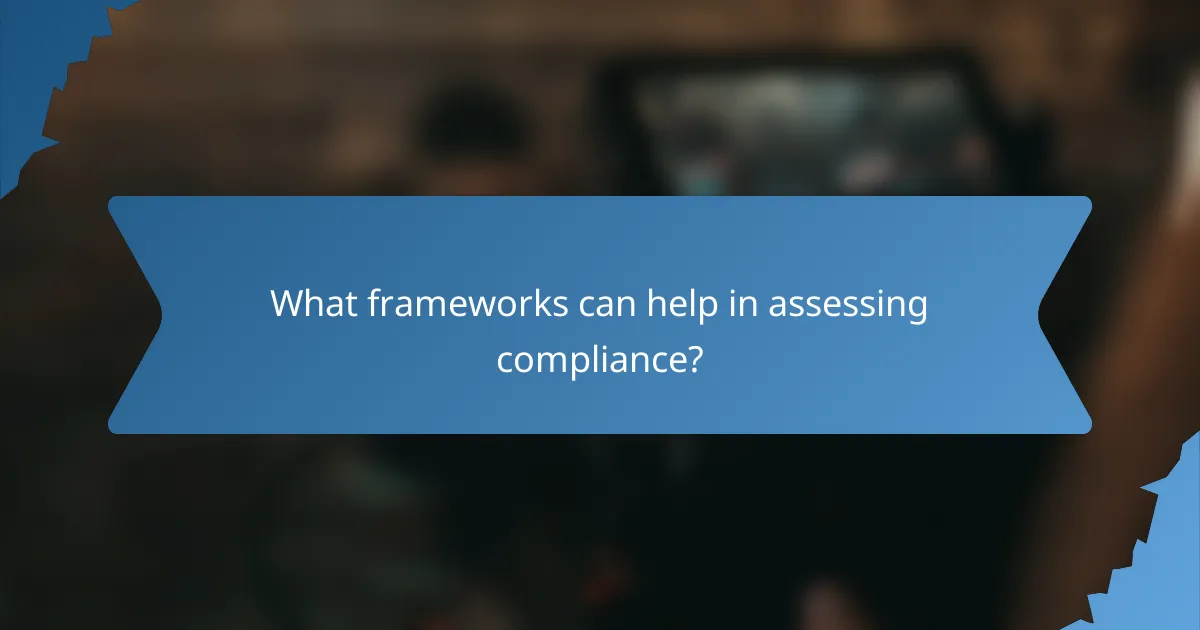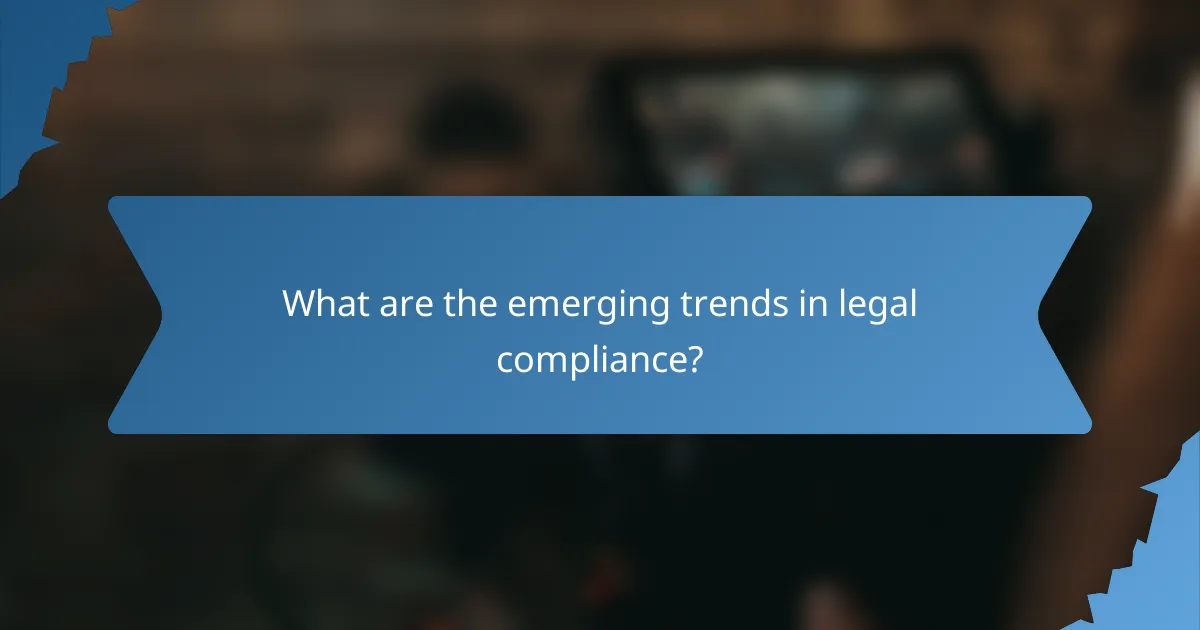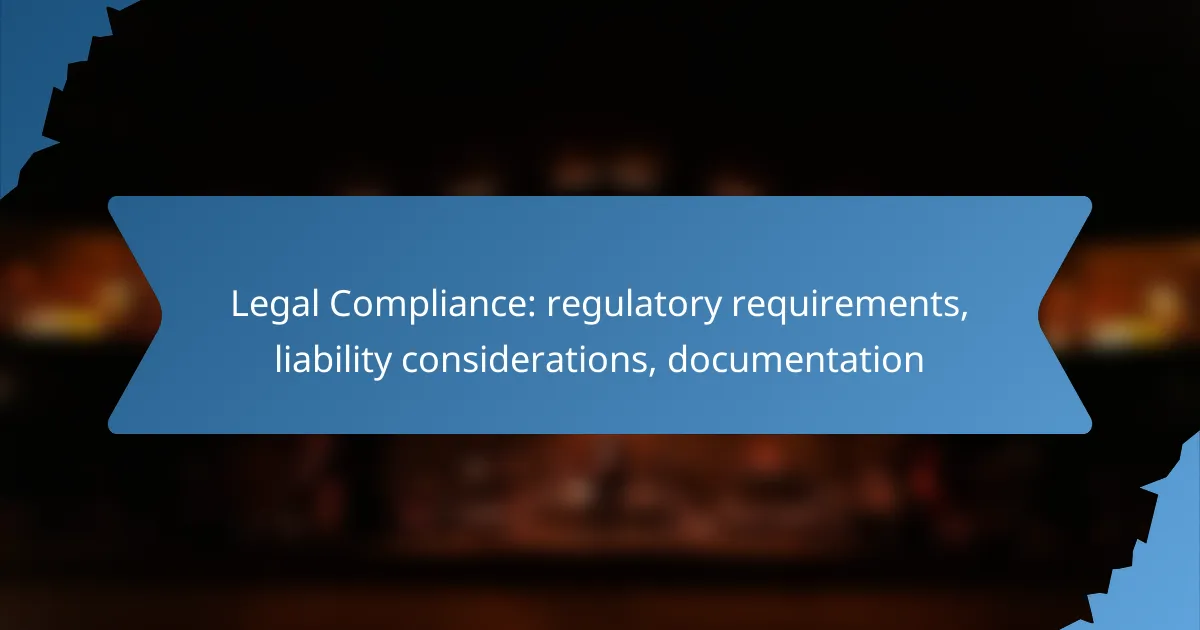Legal compliance is essential for businesses to navigate the complex landscape of regulatory requirements, which vary across federal, provincial, and industry-specific levels. By understanding these regulations and implementing systematic processes, companies can mitigate liability risks and ensure proper documentation practices. Regular evaluations and ongoing employee education play a vital role in maintaining compliance and safeguarding against potential legal responsibilities.

What are the key regulatory requirements in Canada?
In Canada, key regulatory requirements encompass federal, provincial, and industry-specific regulations that businesses must adhere to for legal compliance. Understanding these regulations is crucial for mitigating liability and ensuring proper documentation practices.
Federal regulations
Federal regulations in Canada are established by various government agencies and cover a wide range of sectors. Key regulations include the Canada Business Corporations Act, the Income Tax Act, and the Canadian Environmental Protection Act, which set standards for corporate governance, taxation, and environmental protection.
Businesses must ensure compliance with these federal laws to avoid penalties and legal issues. Regular audits and consultations with legal experts can help maintain adherence to these regulations.
Provincial regulations
Provincial regulations vary significantly across Canada, as each province has the authority to create its own laws. Common areas of regulation include employment standards, health and safety, and consumer protection laws. For instance, Ontario’s Employment Standards Act outlines minimum wage, working hours, and employee rights.
Companies operating in multiple provinces should familiarize themselves with the specific regulations in each area to ensure compliance and avoid potential liabilities. Keeping updated with provincial legislative changes is essential for ongoing compliance.
Industry-specific regulations
Industry-specific regulations are tailored to the unique needs and risks of particular sectors, such as finance, healthcare, and manufacturing. For example, the Financial Transactions and Reports Analysis Centre of Canada (FINTRAC) enforces regulations for financial institutions to prevent money laundering.
Businesses should conduct thorough research to identify relevant industry regulations and implement necessary compliance measures. Engaging with industry associations can provide valuable resources and updates on regulatory changes.

How can businesses ensure legal compliance?
Businesses can ensure legal compliance by implementing systematic processes that address regulatory requirements, liability considerations, and proper documentation. This involves regular evaluations of practices, ongoing education for employees, and seeking expert advice when necessary.
Regular audits
Conducting regular audits is essential for identifying compliance gaps and ensuring adherence to legal standards. These audits can be internal or external and should cover all areas of the business, including financial practices, employee conduct, and operational procedures.
Consider scheduling audits at least annually, but more frequent reviews may be necessary for high-risk industries. Use checklists to streamline the process and ensure all relevant regulations are assessed.
Compliance training programs
Implementing compliance training programs helps employees understand their responsibilities regarding legal requirements. These programs should be tailored to specific roles and updated regularly to reflect changes in laws and regulations.
Training can include workshops, online courses, and practical scenarios. Aim for all employees to complete training at least once a year, with refresher courses as needed to reinforce key concepts.
Consulting legal experts
Engaging legal experts is crucial for navigating complex regulatory landscapes. Lawyers or compliance consultants can provide tailored advice, helping businesses understand their obligations and mitigate potential liabilities.
Consider establishing a relationship with a legal expert who specializes in your industry. Regular consultations can help preemptively address compliance issues and keep your business informed about relevant legal changes.

What are the liability considerations for businesses?
Liability considerations for businesses involve understanding the potential legal responsibilities that can arise from their operations. These responsibilities can lead to financial losses if not managed properly, making it crucial for businesses to identify and mitigate risks associated with their activities.
Types of liability
Businesses face various types of liability, including contractual, tort, and statutory liabilities. Contractual liability arises from agreements with other parties, while tort liability involves harm caused to others, such as negligence claims. Statutory liability refers to violations of laws or regulations that can result in penalties or fines.
For example, a company may be held liable for damages if a product it sells causes injury to a consumer. Understanding these liabilities helps businesses prepare for potential legal challenges and financial repercussions.
Insurance options
To protect against liability, businesses can consider several types of insurance. General liability insurance covers common risks, such as bodily injury and property damage, while professional liability insurance protects against claims of negligence in professional services. Additionally, product liability insurance is essential for businesses that manufacture or sell goods.
Choosing the right insurance depends on the specific risks associated with the business’s operations. It is advisable to consult with an insurance professional to tailor coverage to the unique needs of the business.
Risk management strategies
Effective risk management strategies can significantly reduce liability exposure. Businesses should conduct regular risk assessments to identify potential hazards and implement safety protocols to mitigate them. Training employees on compliance and safety practices is also crucial in minimizing risks.
Additionally, maintaining thorough documentation of policies, procedures, and incidents can provide valuable protection in the event of a liability claim. Regularly reviewing and updating these strategies ensures that businesses remain compliant with evolving regulations and industry standards.

What documentation is necessary for compliance?
Compliance documentation is essential for meeting regulatory requirements and minimizing liability. This typically includes manuals, records, and reports that demonstrate adherence to laws and standards relevant to your industry.
Compliance manuals
Compliance manuals serve as comprehensive guides outlining the policies and procedures necessary for regulatory adherence. They should be tailored to your specific industry and include details on compliance responsibilities, risk management strategies, and relevant laws.
Regular updates to these manuals are crucial to reflect changes in regulations or business operations. Ensure that all employees have access to the latest version and understand its contents to foster a culture of compliance.
Record-keeping practices
Effective record-keeping practices are vital for demonstrating compliance and managing liability. Organizations should maintain accurate and organized records of transactions, communications, and compliance activities for a specified duration, often ranging from three to seven years, depending on the regulation.
Utilizing digital systems can enhance efficiency and accessibility. Regular audits of your record-keeping processes can help identify gaps and ensure that all necessary documentation is retained and easily retrievable.
Reporting requirements
Reporting requirements vary by industry and jurisdiction, but they typically involve submitting periodic reports to regulatory bodies. These reports may include financial statements, compliance audits, and incident reports, which must be accurate and submitted on time to avoid penalties.
Establish a clear schedule for reporting and designate responsible personnel to ensure compliance with deadlines. Familiarize yourself with the specific requirements for your industry to avoid common pitfalls, such as incomplete submissions or late filings.

What frameworks can help in assessing compliance?
Frameworks for assessing compliance provide structured approaches to ensure adherence to laws and regulations. They help organizations identify obligations, manage risks, and document compliance efforts effectively.
Compliance checklists
Compliance checklists are practical tools that outline specific requirements an organization must meet. They can cover various areas, including data protection, financial regulations, and workplace safety. Using checklists helps ensure that no critical steps are overlooked during compliance assessments.
When creating a compliance checklist, prioritize key regulations relevant to your industry. For instance, a checklist for GDPR compliance might include items like data processing agreements and user consent mechanisms. Regularly updating the checklist is crucial to reflect any changes in regulations.
Regulatory compliance software
Regulatory compliance software automates the tracking and management of compliance requirements. These tools can streamline processes, reduce human error, and provide real-time insights into compliance status. Many solutions offer features like document management, audit trails, and reporting capabilities.
When selecting compliance software, consider factors such as ease of use, integration with existing systems, and scalability. Popular options often include features tailored to specific industries, such as healthcare or finance. Investing in regulatory compliance software can save time and resources while enhancing overall compliance efforts.

What are the emerging trends in legal compliance?
Emerging trends in legal compliance focus on integrating technology, enhancing data privacy, and adapting to evolving regulations. Organizations are increasingly prioritizing proactive compliance strategies to mitigate risks and ensure adherence to legal standards.
Impact of technology on compliance
Technology significantly influences compliance by automating processes and improving data management. Tools such as compliance software and artificial intelligence help organizations monitor regulations and manage documentation efficiently.
For instance, automated reporting systems can streamline the collection and analysis of compliance data, reducing human error and saving time. Companies may also use blockchain technology for secure and transparent record-keeping, which enhances accountability.
However, organizations must remain vigilant about cybersecurity risks associated with these technologies. Regular audits and updates to security protocols are essential to protect sensitive information and maintain compliance with data protection regulations.
